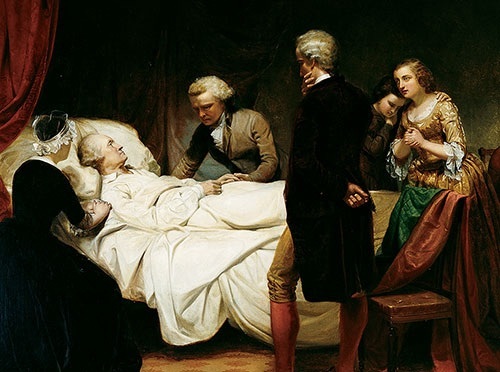History in Art, #1
 Life of George Washington – Deathbed (1851) by Junius Brutus Stearns
Life of George Washington – Deathbed (1851) by Junius Brutus StearnsDoctor, I die hard; but I am not afraid to go; I believed from my first attack that I should not survive it; my breath can not last long.
Haunting and poignant, these are George Washington’s final recorded words, spoken as life slipped from his body.
His death occurred on December 14, 1799. He had lived to the age of sixty-seven. In life, he had built a reputation as a strong and capable leader, fending off the strongest army with poorly trained but determined soldiers. He was now regarded as almost superhuman.
However, in these final moments, illness reminded him of his humanity. We all become ill sometimes—and at one point, it will be the last time.
These final words were recounted by Washington’s secretary, Tobias Lear. Lear was in the room with Martha and the physicians, waiting for the inevitable.
According to Lear, Washington continued: “Do you arrange and record all my late military papers—arrange my accounts and settle my books, as you know more about them than any one else, and let Mr. Rawlins finish recording my other letters which he had begun.”
Washington’s body, as he spoke, was weakened by infection. An 1851 oil painting by Junius Brutus Stearns aspires to capture these moments. It is a gripping piece, heavy with emotions like awe and finality.
Washington’s election as the first President was nearly unanimous (except for Washington himself, who did not want the title). His beloved home, Mount Vernon, was a lifelong project. Today, it remains—an elegant, dignified reflection of its master’s spirit.
It can be thought of as our house, the home of the people. Ironically, Washington had no natural children of his own. His adopted son and daughter—children of his wife, Martha—both died young. He has left an impressive legacy, all the same.
His Excellency by Joseph J. Ellis describes the almost trivial circumstances which led to Washington’s illness. They began after he went riding on a cold, December day in 1799:
Despite a storm that deposited a blanket of snow, sleet, and hail on the region, Washington maintained his regular routine, riding his rounds for five hours in the storm, then choosing not to change his wet clothes, because dinner was ready upon his return and he did not wish to inconvenience his guests with a delay. The following day he was hoarse, but insisted on going out in the still inclement weather to mark some trees for cutting. He presumed he had caught a cold, and felt the best treatment was to ignore it: “Let it go as it came,” as he explained.
Let it go as it came—but it did not. The weather was severely cold; due to his advanced age, Washington was perhaps more vulnerable to the maladies of cold.
That night, he found himself suffering from shortness of breath and a severe pain in his throat. He woke Martha:
Word went out at dawn to fetch Lear and Dr. James Craik, Washington’s personal physician and friend for over forty years. Craik immediately diagnosed Washington’s condition as serious, possibly terminal, and he dispatched riders to bring two local physicians to Mount Vernon to assist him in prescribing treatment.
But nothing could be done. As was the custom, physicians bled him in hopes that the infection would be flushed out. Today, we know that the human body does not work like that. Many believe that he died faster because of the amount of blood that he lost.
I have twice visited Mount Vernon, twice seen the room in which he died, decorated in such a manner that it seems I stepped back in time. The painting is a powerful reminder that times change, medicine advances, and heroes remain bright in our nation’s history. It is more impressive, even, than the real thing.



